Sustainable Concrete with Recycled Aggregate from Plastic Waste: Physical–Mechanical Behavior
Abstract
Featured Application
Abstract
1. Introduction
| PET | PET | HDPE | Rubber | PP | PVC | E-waste | Fine | Coarse | Fibers | Others |
|---|---|---|---|---|---|---|---|---|---|---|
| Mousavimehr and Nematzadeh, 2020 [35] | X | Mixed PET/rubber | ||||||||
| Abdal Qadir and Noaman, 2024 [11] | X | X | X | X | Mixed with steel fibers | |||||
| Bamigboye et al., 2022 [12] | X | X | ||||||||
| Abu-Saleem et al., 2021a [22] | X | X | X | X | ||||||
| Skibicki et al., 2022 [14] | X | X | ||||||||
| Tayeh et al., 2021 [15] | X | X | X | |||||||
| Abu-Saleem et al., 2021b [17] | X | X | Mixed PET/PP/PEAD | |||||||
| Supit and Priyono, 2022 [16] | X | X | X | X | Mixed fibers; PP and PET | |||||
| Chan et al., 2022 [18] | X | X | X | X | ||||||
| Babafemi et al., 2022 [13] | X | Mixed plastics | ||||||||
| Abu-Saleem et al., 2021c [36] | X | Mixed PET, HDPE, PP | ||||||||
| Lazorenko et al., 2022 [21] | X | X | ||||||||
| Kangavar et al., 2022 [37] | X | X | ||||||||
| Jaskowska-Lemańska et al., 2022 [20] | X | X | ||||||||
| Farina et al., 2022 [19] | X | X | ||||||||
| Askar et al., 2023 [7] | X | X | X | X | X | X | X | Review | ||
| Mohammed et al., 2021 [24] | X | X | ||||||||
| El-Seidy et al., 2023 [25] | X | X | Mixed PVC/glass | |||||||
| Senhadji et al., 2015 [26] | X | X | X | |||||||
| Arnaud et al., 2024 [23] | X | X | X | X | ||||||
| Noor-Azline et al., 2023 [27] | X | Review | ||||||||
| Mohammed et al., 2019 [28] | X | |||||||||
| Ullah et al., (2021) [29] | X | X | ||||||||
| Ahmad, Qureshi, et al., (2022) [30] | X | X | Mixed nanographite | |||||||
| Makri et al., (2019) [31] | X | X | Mortar | |||||||
| Ahmad, Jamal, et al., (2022) [32] | X | X | ||||||||
| Abbas et al., (2022) [33] | X | X | ||||||||
| Chang-Chi et al., (2025) [34] | X | X | Mortar |
2. Materials and Methods
| PROPERTY | REGULATIONS | CNA | CRPA | FNA | FRPA |
|---|---|---|---|---|---|
| Density | ASTM C128/C127 [54,55] | 2.69 | 2.01 | 2.62 | 1.14 |
| Absorption (%) | ASTM C128/C127 [54,55] | 0.53 | 6.09 | 2.41 | NA |
| Dry compact volumetric weight (kg/m3) | ASTM C29 [56] | 1565.5 | 1182 | NA | |
| Fineness modulus | ASTM C33 [52] | NA | 2.4 | ||
| Resistance to degradation (%) | ASTM C131 [57] | 23.2 | 42.8 | NA | |
| Granulometry | ASTM C33 [52] | See Figure 2 | |||
3. Results
4. Conclusions
Author Contributions
Funding
Institutional Review Board Statement
Informed Consent Statement
Data Availability Statement
Acknowledgments
Conflicts of Interest
Abbreviations
| RPAs | Recycled plastic aggregates |
| FRPAs | Fine recycled plastic aggregates |
| CRPAs | Coarse recycled plastic aggregates |
| PET | Polyethylene terephthalate |
| HDPE | High density polyethylene |
| PP | Polypropylene |
| TP | Thermoplastic paint |
References
- Vázquez-Morillas, A.; Alvarez-Zeferino, J.C.; Cruz-Salas, A.A.; Martínez-Salvador, C.; Tapia-Fuentes, J.; Hermoso-López Araiza, J.P.; Beltrán-Villavicencio, M.; Espinosa-Valdemar, R.M.; Rosillo-Pantoja, I.; Velasco-Pérez, M. Inventories of plastic pollution sources, flows and hotspots as a baseline for national action plans: The experience of Mexico. Sci. Total Environ. 2024, 957, 177338. [Google Scholar] [CrossRef]
- Mashaan, N.S. Waste plastic in concrete: Review and state of the art. Nanotechnol. Percept. 2024, 20, 594–612. Available online: https://nano-ntp.com/index.php/nano/article/view/2534/1895 (accessed on 20 January 2025).
- SEMARNAT. Inventario Nacional de Fuentes de Contaminación Plástica; 2023. Available online: http://data.sedema.cdmx.gob.mx:9000/datos/biblioteca-detalle/inventario-nacional-de-contaminacion-plastica-en-mexico (accessed on 20 January 2025).
- Lamba, P.; Kaur, D.P.; Raj, S.; Sorout, J. Recycling/reuse of plastic waste as construction material for sustainable development: A review. Environ. Sci. Pollut. Res. 2022, 29, 86156–86179. [Google Scholar] [CrossRef]
- Marvila, M.; de Matos, P.; Rodríguez, E.; Monteiro, S.N.; de Azevedo, A.R.G. Recycled aggregate: A viable solution for sustainable concrete production. Materials 2022, 15, 5276. [Google Scholar] [CrossRef]
- Boni, A.; Farfán, M.; Pérez-Vega, A. The role of zoning in the mining activity within federal natural protected areas of Mexico. Investig. Geogr. 2019, 99, 2448–7279. [Google Scholar] [CrossRef]
- Askar, M.K.; Al-Kamaki, Y.S.S.; Hassan, A. Utilizing polyethylene terephthalate PET in concrete: A review. Polymers 2023, 15, 3320. [Google Scholar] [CrossRef]
- Abu-Saleem, M.; Zhuge, Y.; Hassanli, R.; Ellis, M.; Rahman, M.M.; Levett, P. Stress-strain behaviour and mechanical strengths of concrete incorporating mixed recycled plastics. J. Compos. Sci. 2021, 5, 146. [Google Scholar] [CrossRef]
- Usman, I.U.; Kunlin, M. Influence of polyethylene terephthalate (PET) utilization on the engineering properties of asphalt mixtures: A review. Constr. Build. Mater. 2024, 411, 134439. [Google Scholar] [CrossRef]
- Arulrajah, A.; Perera, S.; Wong, Y.C.; Maghool, F.; Horpibulsuk, S. Stabilization of PET plastic-demolition waste blends using fly ash and slag-based geopolymers in light traffic road bases/subbases. Constr. Build. Mater. 2021, 284, 122809. [Google Scholar] [CrossRef]
- Abdal Qadir, I.M.; Noaman, A.T. Effect of combination between hybrid fibers and rubber aggregate on rheological and mechanical properties of self-compacting concrete. Constr. Build. Mater. 2024, 414, 135038. [Google Scholar] [CrossRef]
- Bamigboye, G.; Tarverdi, K.; Adigun, D.; Daniel, B.; Okorie, U.; Adediran, J. An appraisal of the mechanical, microstructural, and thermal characteristics of concrete containing waste PET as coarse aggregate. Clean. Waste Syst. 2022, 1, 100001. [Google Scholar] [CrossRef]
- Babafemi, A.J.; Sirba, N.; Paul, S.C.; Miah, M.J. Mechanical and durability assessment of recycled waste plastic (resin8 & PET) eco-aggregate concrete. Sustainability 2022, 14, 5725. [Google Scholar] [CrossRef]
- Skibicki, S.; Pułtorak, M.; Kaszyńska, M.; Hoffmann, M.; Ekiert, E.; Sibera, D. The Effect of Using Recycled PET aggregates on mechanical and durability properties of 3D printed mortar. Constr. Build. Mater. 2022, 335, 127443. [Google Scholar] [CrossRef]
- Tayeh, B.A.; Almeshal, I.; Magbool, H.M.; Alabduljabbar, H.; Alyousef, R. Performance of sustainable concrete containing different types of recycled plastic. J. Clean. Prod. 2021, 328, 129517. [Google Scholar] [CrossRef]
- Supit, S.W.M. Utilization of recycled PET plastic waste as replacement of coarse aggregate in pervious concrete. Mater. Today Proc. 2022, 66, 2990–2995. [Google Scholar] [CrossRef]
- Abu-Saleem, M.; Zhuge, Y.; Hassanli, R.; Ellis, M.; Rahman, M.M.; Levett, P. Microwave radiation treatment to improve the strength of recycled plastic aggregate concrete. Case Stud. Constr. Mater. 2021, 15, e00728. [Google Scholar] [CrossRef]
- Chan, L.H.; Aziz, Z.A.; Bin Ghazali, M.A. The performance of lightweight concrete with recycled polyethylene terephthalate and polypropylene as demising wall. Environ. Clim. Technol. 2022, 26, 1323–1336. [Google Scholar] [CrossRef]
- Farina, I.; Moccia, I.; Salzano, C.; Singh, N.; Sadrolodabaee, P.; Colangelo, F. Compressive and thermal properties of non-structural lightweight concrete containing industrial byproduct aggregates. Materials 2022, 15, 4029. [Google Scholar] [CrossRef]
- Jaskowska-Lemańska, J.; Kucharska, M.; Matuszak, J.; Nowak, P.; Łukaszczyk, W. Selected properties of self-compacting concrete with recycled PET aggregate. Materials 2022, 15, 2566. [Google Scholar] [CrossRef]
- Lazorenko, G.; Kasprzhitskii, A.; Fini, E.H. Polyethylene terephthalate (PET) waste plastic as natural aggregate replacement in geopolymer mortar production. J. Clean. Prod. 2022, 375, 134083. [Google Scholar] [CrossRef]
- Abu-Saleem, M.; Zhuge, Y.; Hassanli, R.; Ellis, M.; Rahman, M.; Levett, P. Evaluation of concrete performance with different types of recycled plastic waste for kerb application. Constr. Build. Mater. 2021, 293, 123477. [Google Scholar] [CrossRef]
- Arnaud, K.N.; Arnold, M.M.; Aubain, D.D.; Emmanuel, Y.; Billong, N.; Hyeng Bock, C. Study of the performance of HDPE and PVC plastic aggregates in concrete. Int. J. Pavement Res. Technol. 2024. [Google Scholar] [CrossRef]
- Mohammed, N.S.; Hamza, B.A.; Al-Shareef, N.H.; Hussein, H.H. Structural behavior of reinforced concrete slabs containing fine waste aggregates of polyvinyl chloride. Buildings 2021, 11, 26. [Google Scholar] [CrossRef]
- El-Seidy, E.; Chougan, M.; Sambucci, M.; Al-Kheetan, M.J.; Biblioteca, I.; Valente, M.; Hamidreza Ghaffar, S. Lightweight alkali-activated materials and ordinary portland cement composites using recycled polyvinyl chloride and waste glass aggregates to fully replace natural sand. Constr. Build. Mater. 2023, 368, 130399. [Google Scholar] [CrossRef]
- Senhadji, Y.; Escadeillas, G.; Benosman, A.S.; Mouli, M.; Khelafi, H.; Ould-Kaci, S. Effect of incorporating PVC waste as aggregate on the physical, mechanical, and chloride ion penetration behavior of concrete. J. Adhes. Sci. Technol. 2015, 29, 625–640. [Google Scholar] [CrossRef]
- Azline, N.M.N.; Byron, K.N.; Aznieta, F.N.A.A.; Ernaleza, M. A brief review on polyvinyl chloride plastic as aggregate for construction materials. J. Eng. Appl. Sci. 2023, 70, 142. [Google Scholar] [CrossRef]
- Mohammed, A.A.; Mohammed, I.I.; Mohammed, S.A. Some properties of concrete with plastic aggregate derived from shredded PVC sheets. Constr. Build. Mater. 2019, 201, 232–245. [Google Scholar] [CrossRef]
- Ullah, Z.; Qureshi, M.I.; Ahmad, A.; Khan, S.U.; Javaid, M.F. An experimental study on the mechanical and durability properties assessment of E-waste concrete. J. Build. Eng. 2021, 38, 102177. [Google Scholar] [CrossRef]
- Ahmad, F.; Qureshi, M.I.; Ahmad, Z. Influence of nano graphite platelets on the behavior of concrete with E-waste plastic coarse aggregates. Constr. Build. Mater. 2022, 316, 125980. [Google Scholar] [CrossRef]
- Makri, C.; Hahladakis, J.N.; Gidarakos, E. Use and assessment of “e-Plastics” as recycled aggregates in cement mortar. J. Hazard. Mater. 2019, 379, 120776. [Google Scholar] [CrossRef]
- Ahmad, F.; Jamal, A.; Mazher, K.M.; Umer, W.; Iqbal, M. Performance evaluation of plastic concrete modified with E-waste plastic as a partial replacement of coarse aggregate. Materials 2022, 15, 175. [Google Scholar] [CrossRef]
- Abbas, S.N.; Qureshi, M.I.; Abid, M.; Tariq, M.A.U.R.; Ng, A.W.M. An investigation of mechanical properties of concrete by applying sand coating on recycled high-density polyethylene (HDPE) and electronic-wastes (E-Wastes) used as a partial replacement of natural coarse aggregates. Sustainability 2022, 14, 4087. [Google Scholar] [CrossRef]
- Hung, C.C.; Wu, C.H.; Wang, H.Y.; Lo, C.F.; Wang, C.C.; Tsai, S.L. Engineering properties of television plastic shell waste (TPSW) to replace part of sand–cement mortar. Appl. Sci. 2025, 15, 1559. [Google Scholar] [CrossRef]
- Mousavimehr, M.; Nematzadeh, M. Post-heating flexural behavior and durability of hybrid PET–rubber aggregate concrete. Constr. Build. Mater. 2020, 265, 120359. [Google Scholar] [CrossRef]
- Abu-Saleem, M.; Zhuge, Y.; Hassanli, R.; Ellis, M.; Rahman, M.M.; Levett, P. Impact resistance and sodium sulphate attack testing of concrete incorporating mixed types of recycled plastic waste. Sustainability 2021, 13, 9521. [Google Scholar] [CrossRef]
- Kangavar, M.E.; Lokuge, W.; Manalo, A.; Karunasena, W.; Frigione, M. Investigation on the properties of concrete with recycled polyethylene terephthalate (PET) granules as fine aggregate replacement. Case Stud. Constr. Mater. 2022, 16, e00934. [Google Scholar] [CrossRef]
- Foti, D. 18—Recycled waste PET for sustainable fiber-reinforced concrete. In Woodhead Publishing Series in Civil and Structural Engineering; Pacheco-Torgal, F., Khatib, J., Colangelo, F., Tuladhar, R.B.T.U., Eds.; Woodhead Publishing: Sawston, UK, 2019; pp. 387–410. ISBN 978-0-08-102676-2. [Google Scholar]
- Coviello, C.G.; La Scala, A.; Sabbà, M.F.; Carnimeo, L. On the cementitious mixtures reinforced with waste polyethylene terephthalate. Materials 2024, 17, 5351. [Google Scholar] [CrossRef]
- Coviello, C.G.; Sabbà, M.F.; Foti, D. Recycled waste PET for sustainable cementitious materials. Ref. Modul. Mater. Sci. Mater. Eng. 2024, 17, 232–260. [Google Scholar] [CrossRef]
- Nasir, A.; Butt, F.; Ahmad, F. Enhanced mechanical and axial resilience of recycled plastic aggregate concrete reinforced with silica fume and fibers. Innov. Infrastruct. Solut. 2024, 10, 4. [Google Scholar] [CrossRef]
- Amjad, H.; Ahmad, F.; Irshad Qureshi, M. Enhanced mechanical and durability resilience of plastic aggregate concrete modified with nano-iron oxide and sisal fiber reinforcement. Constr. Build. Mater. 2023, 401, 132911. [Google Scholar] [CrossRef]
- Faraj, R.H.; Mohammed, A.A.; Omer, K.M. Synergistic effects of recycled plastic aggregate and nano-silica on the elevated temperature and durability performance of self-compacting concrete. J. Build. Eng. 2023, 75, 106986. [Google Scholar] [CrossRef]
- Faraj, R.H.; Mohammed, A.A.; Omer, K.M. Microstructure characteristics, stress–strain behaviour, fresh properties, and mechanical performance of recycled plastic aggregate self-compacting concrete modified with nano-silica. Constr. Build. Mater. 2023, 383, 131371. [Google Scholar] [CrossRef]
- Sadrmomtazi, A.; Dolati-Milehsara, S.; Lotfi-Omran, O.; Sadeghi-Nik, A. The combined effects of waste polyethylene terephthalate (PET) particles and pozzolanic materials on the properties of selfcompacting concrete. J. Clean. Prod. 2016, 112, 2363–2373. [Google Scholar] [CrossRef]
- Ajayi, B.L.; Babafemi, A.J. Effects of waste plastic and glass aggregates on the strength properties of ambient-cured one-part metakaolin-based geopolymer concrete. Appl. Sci. 2024, 14, 1856. [Google Scholar] [CrossRef]
- Cheon, H.; Ruziev, J.; Lee, H.; Kang, Y.; Roh, S.; Kim, W. Mechanical properties of cement composites using modified plastics by gamma irradiation. Appl. Sci. 2021, 11, 11982. [Google Scholar] [CrossRef]
- Gravina, R.J.; Xie, T.; Bennett, B.; Visintin, P. HDPE and PET as aggregate replacement in concrete: Life-cycle assessment, material development and a case study. J. Build. Eng. 2021, 44, 103329. [Google Scholar] [CrossRef]
- Kazemi, M.; Faisal Kabir, S.; Fini, E.H. State of the art in recycling waste thermoplastics and thermosets and their applications in construction. Resour. Conserv. Recycl. 2021, 174, 105776. [Google Scholar] [CrossRef]
- Chaudhary, A.; Akhtar, A. A novel approach for environmental impact assessment of road construction projects in India. Environ. Impact Assess. Rev. 2024, 106, 107477. [Google Scholar] [CrossRef]
- SMIE. Normas Técnicas Complementarias Para Diseño y Construcción de Estructuras de Concreto; Portal de Transparencia de la CDMX: Mexico City, Mexico, 2022.
- C33/C33M-18; Standard Specification for Concrete Aggregates. ASTM: West Conshohocken, PA, USA, 2018. Available online: https://www.astm.org/c0033_c0033m-16e01.html (accessed on 20 January 2025).
- ASTM C150-07; Standard Specification for Portland Cement. ASTM: West Conshohocken, PA, USA, 2007. Available online: https://www.astm.org/c0150_c0150m-22.html (accessed on 20 January 2025).
- ASTM C128; Standard Test Method for Specific Gravity and Absorption of Fine Aggregate. ASTM: West Conshohocken, PA, USA, 2022. Available online: https://www.astm.org/c0128-22.html (accessed on 20 January 2025).
- ASTM C127; Standard Test Method for Relative Density (Specific Gravity) and Absorption of Coarse Aggregate. ASTM: West Conshohocken, PA, USA, 2024. Available online: https://www.astm.org/standards/c127 (accessed on 20 January 2025).
- ASTM C29/C29M-23; Standard Test Method for Bulk Density (“Unit Weight”) and Voids in Aggregate. ASTM: West Conshohocken, PA, USA, 2023. Available online: https://www.astm.org/c0029_c0029m-23.html (accessed on 20 January 2025).
- ASTM C131-06; Standard Test Method for Resistance to Degradation of Small-Size Coarse Aggregate by Abrasion and Impact in the Los Angeles Machine. ASTM: West Conshohocken, PA, USA, 2006. Available online: https://www.astm.org/c0131-06.html (accessed on 20 January 2025).
- ACI PRC-211.1-22; Selecting Proportions for Normal-Density and High-Density Concrete—Guide. ACI: Omaha, NE, USA, 2022. Available online: https://www.concrete.org/store/productdetail.aspx?ItemID=211122&Language=English&Units=US_Units (accessed on 20 January 2025).
- ASTM C192-19; Standard Practice for Making and Curing Concrete Test Specimens in the Laboratory. ASTM: West Conshohocken, PA, USA, 2019. Available online: https://www.astm.org/c0192_c0192m-19.html (accessed on 20 January 2025).
- ASTM C143/C143M-12; Standard Test Method for Slump of Hydraulic-Cement Concrete. ASTM: West Conshohocken, PA, USA, 2012. Available online: https://www.astm.org/c0143_c0143m-12.html (accessed on 20 January 2025).
- ASTM C805-18; Standard Test Method for Rebound Number of Hardened Concrete. ASTM: West Conshohocken, PA, USA, 2018. Available online: https://www.astm.org/c0805_c0805m-18.html (accessed on 20 January 2025).
- ASTM C39/C39M-21; Standard Test Method for Compressive Strength of Cylindrical Concrete Specimens. ASTM: West Conshohocken, PA, USA, 2021. Available online: https://www.astm.org/c0039_c0039m-21.html (accessed on 20 January 2025).
- ASTM C293/C293M-16; Standard Test Method for Flexural Strength of Concrete (Using Simple Beam With Center-Point Loading). ASTM: West Conshohocken, PA, USA, 2016. Available online: https://www.astm.org/c0293_c0293m-16.html (accessed on 20 January 2025).
- ASTM C642-21; Standard Test Method for Density, Absorption, and Voids in Hardened Concrete. ASTM: West Conshohocken, PA, USA, 2021. Available online: https://www.astm.org/standards/c642 (accessed on 20 January 2025).
- El-Nadoury, W.W. Chemically treated plastic replacing fine aggregate in structural concrete. Front. Mater. 2022, 9, 948117. [Google Scholar] [CrossRef]
- Belmokaddem, M.; Mahi, A.; Senhadji, Y.; Pekmezci, B.Y. Mechanical and physical properties and morphology of concrete containing plastic waste as aggregate. Constr. Build. Mater. 2020, 257, 119559. [Google Scholar] [CrossRef]
- Al-Mansour, A.; Zhu, Y.; Lan, Y.; Dang, N.; Alwathaf, A.H.; Zeng, Q. Improving the Adhesion Between Recycled Plastic Aggregates and the Cement Matrix; LTD: Nottingham, UK, 2024; ISBN 9780443137983. [Google Scholar]
- Almeshal, I.; Tayeh, B.A.; Alyousef, R.; Alabduljabbar, H.; Mustafa Mohamed, A.; Alaskar, A. Use of recycled plastic as fine aggregate in cementitious composites: A review. Constr. Build. Mater. 2020, 253, 119146. [Google Scholar] [CrossRef]


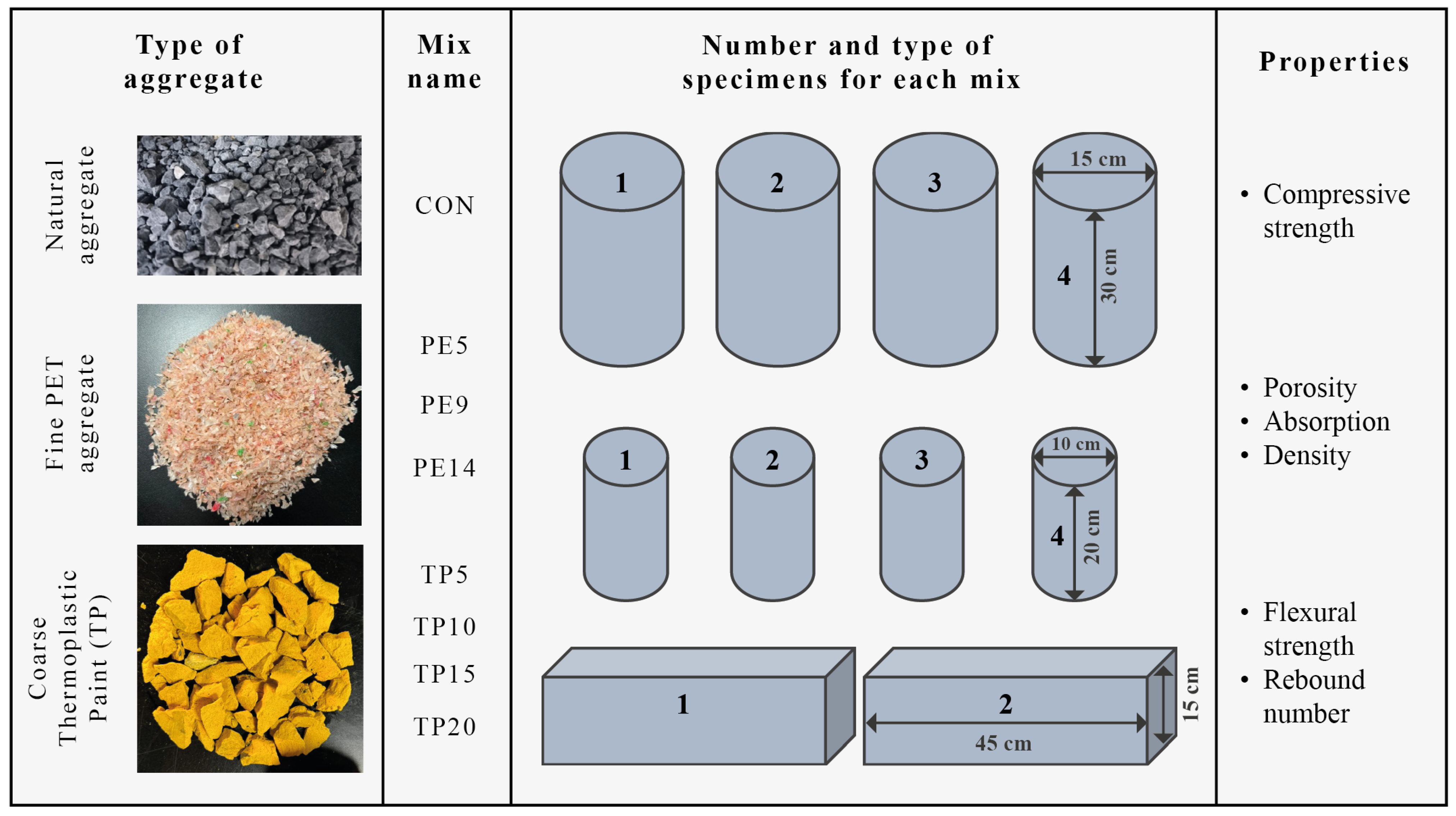
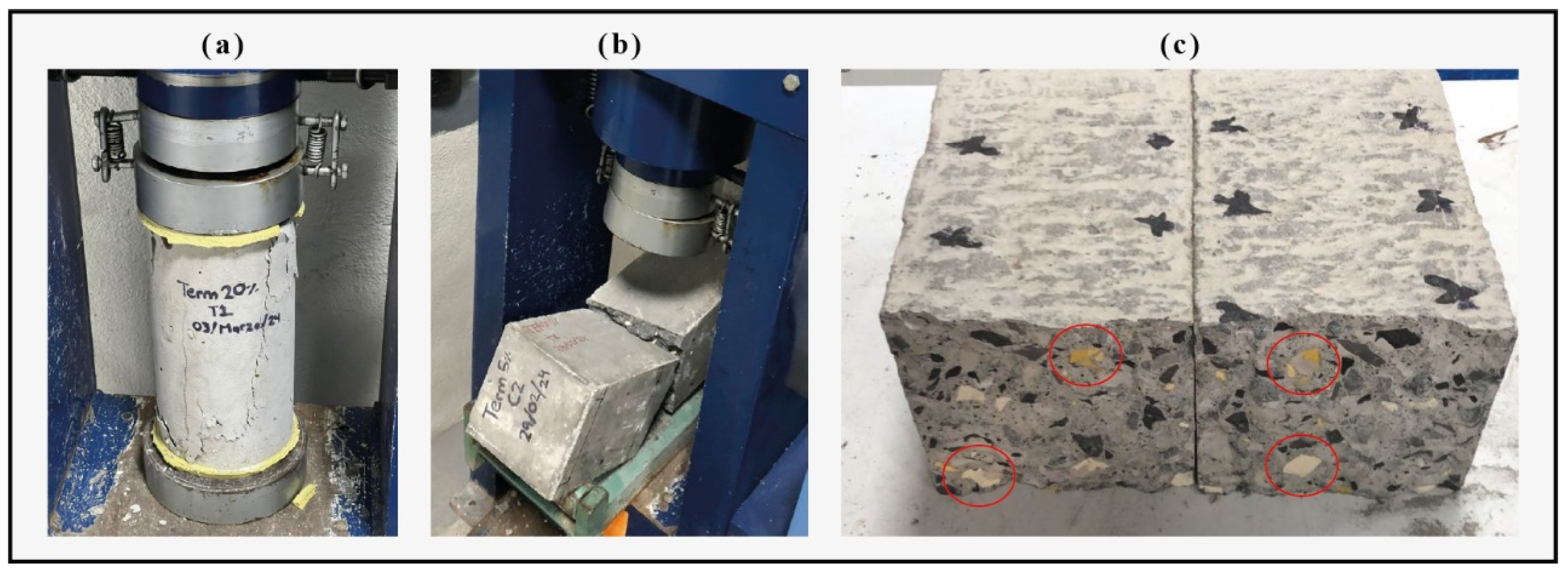
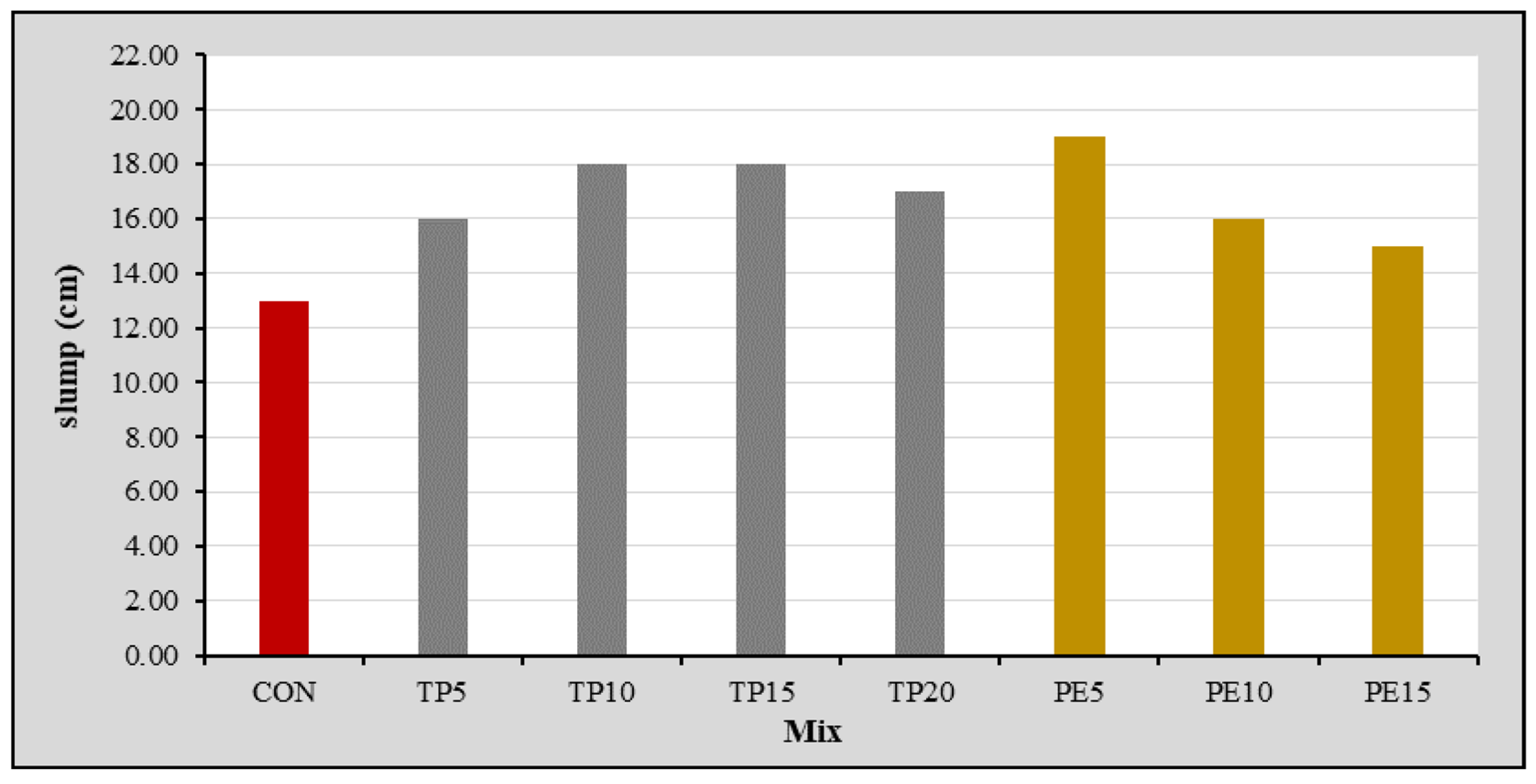

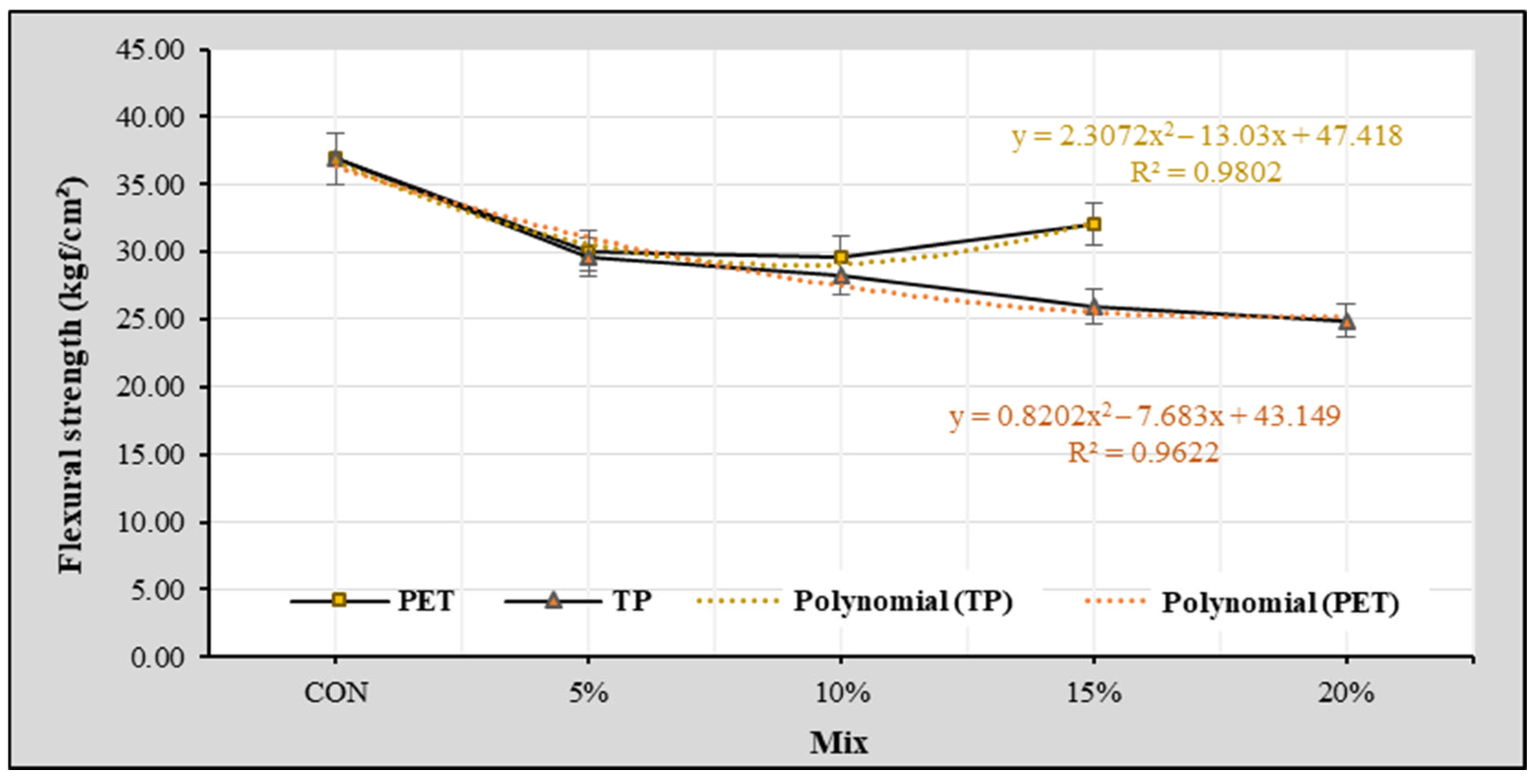
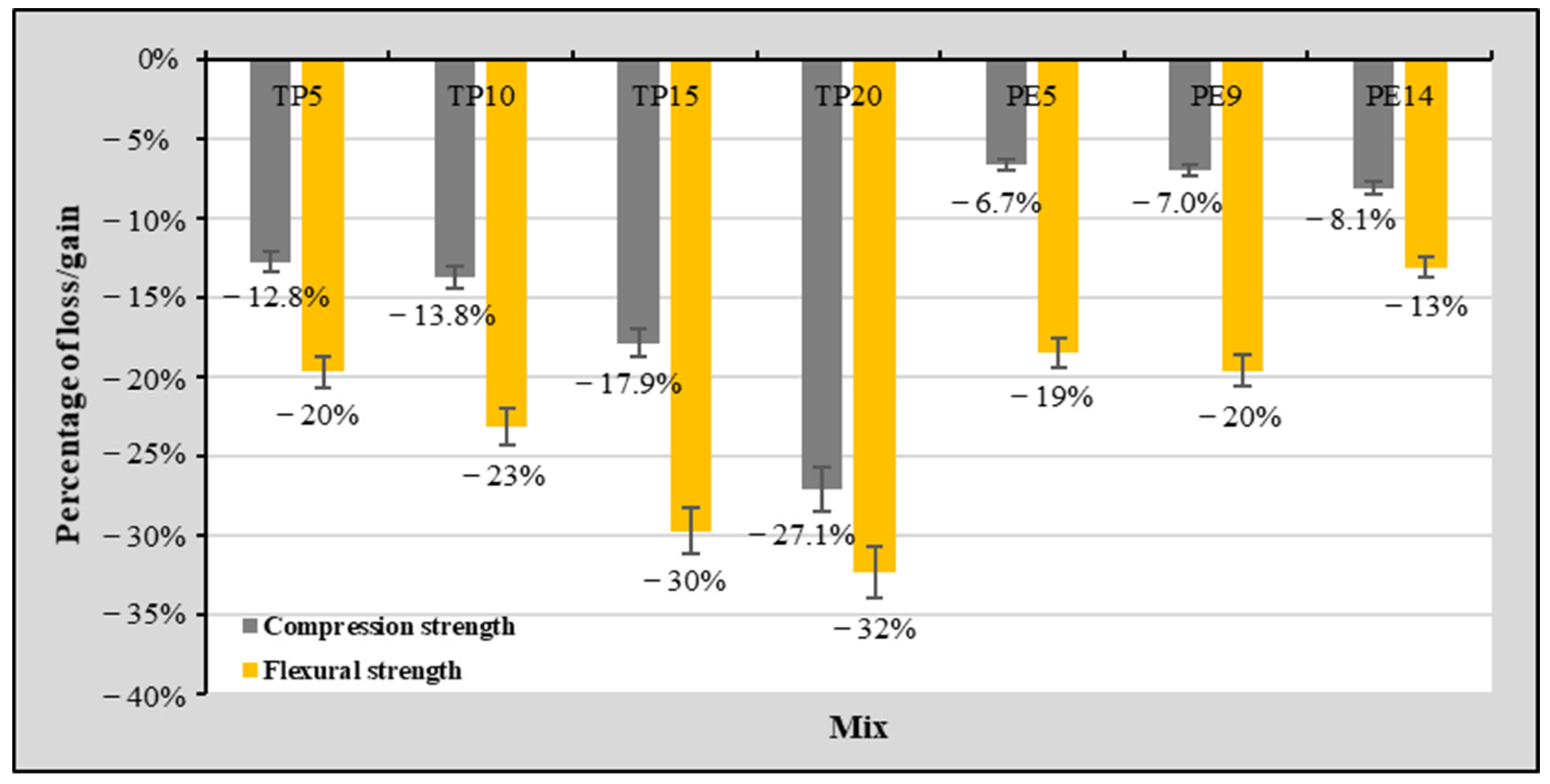
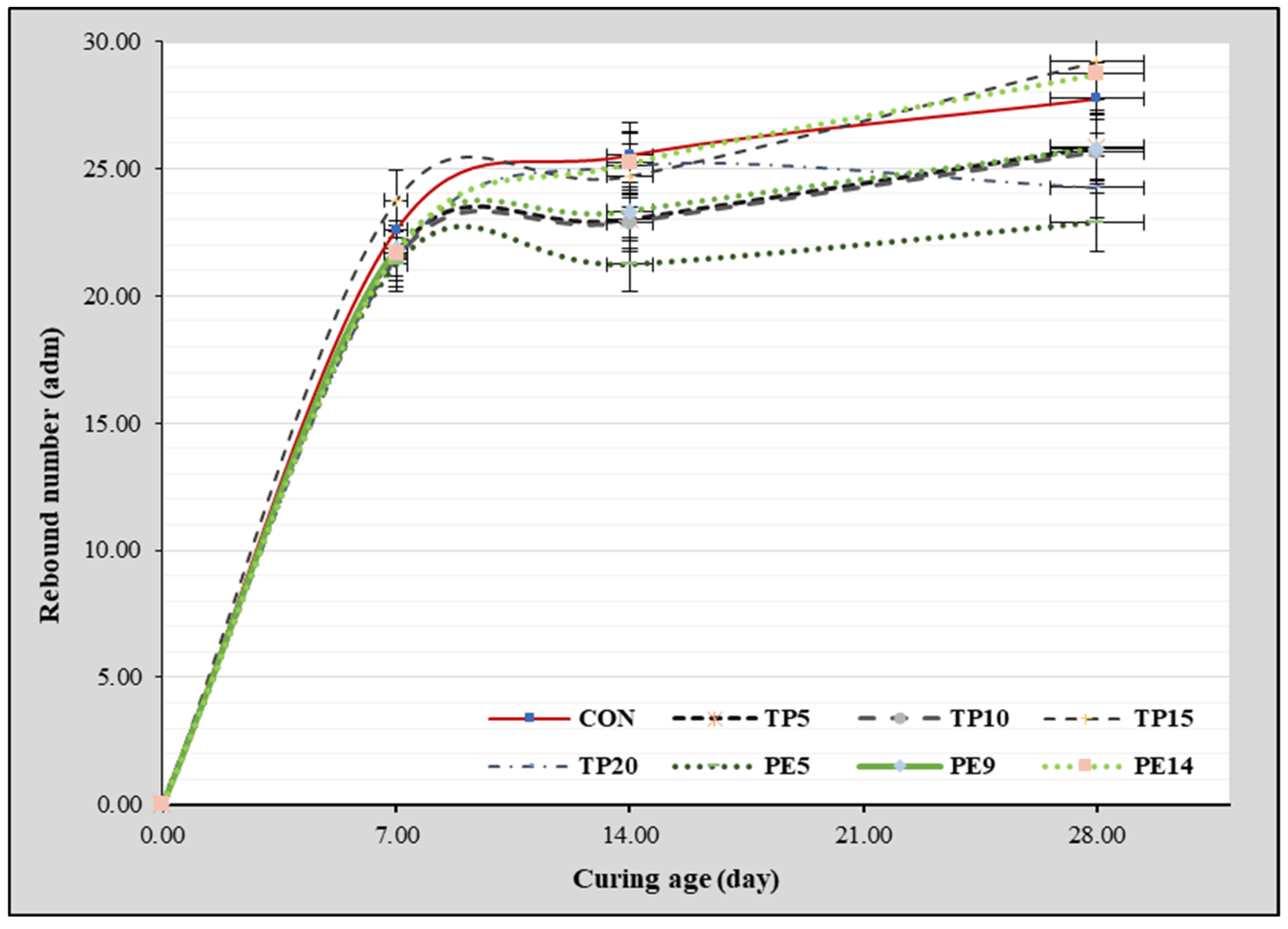

| Coarse Aggregate | Fine Aggregate | |||||
|---|---|---|---|---|---|---|
| Mix | Cement | Water | Natural | TP | Natural | PET |
| CON | 427.08 | 226.49 | 1028.99 | 0.00 | 646.65 | - |
| TP5 | 427.08 | 228.84 | 988.86 | 36.75 | 646.65 | - |
| TP10 | 427.08 | 231.24 | 948.96 | 74.45 | 646.65 | - |
| TP15 | 427.08 | 233.71 | 908.02 | 113.15 | 646.65 | - |
| TP20 | 427.08 | 236.25 | 865.98 | 152.87 | 646.65 | - |
| PE5 | 427.08 | 226.49 | 1028.99 | - | 633.72 | 12.93 |
| PE9 | 427.08 | 226.49 | 1028.99 | - | 620.79 | 25.87 |
| PE14 | 427.08 | 226.49 | 1028.99 | - | 607.86 | 38.80 |
Disclaimer/Publisher’s Note: The statements, opinions and data contained in all publications are solely those of the individual author(s) and contributor(s) and not of MDPI and/or the editor(s). MDPI and/or the editor(s) disclaim responsibility for any injury to people or property resulting from any ideas, methods, instructions or products referred to in the content. |
© 2025 by the authors. Licensee MDPI, Basel, Switzerland. This article is an open access article distributed under the terms and conditions of the Creative Commons Attribution (CC BY) license (https://creativecommons.org/licenses/by/4.0/).
Share and Cite
Gámez-García, D.C.; Vargas-Leal, A.J.; Serrania-Guerra, D.A.; González-Borrego, J.G.; Saldaña-Márquez, H. Sustainable Concrete with Recycled Aggregate from Plastic Waste: Physical–Mechanical Behavior. Appl. Sci. 2025, 15, 3468. https://doi.org/10.3390/app15073468
Gámez-García DC, Vargas-Leal AJ, Serrania-Guerra DA, González-Borrego JG, Saldaña-Márquez H. Sustainable Concrete with Recycled Aggregate from Plastic Waste: Physical–Mechanical Behavior. Applied Sciences. 2025; 15(7):3468. https://doi.org/10.3390/app15073468
Chicago/Turabian StyleGámez-García, Diana Carolina, Adrián Jesús Vargas-Leal, David Armando Serrania-Guerra, Julián Graciano González-Borrego, and Héctor Saldaña-Márquez. 2025. "Sustainable Concrete with Recycled Aggregate from Plastic Waste: Physical–Mechanical Behavior" Applied Sciences 15, no. 7: 3468. https://doi.org/10.3390/app15073468
APA StyleGámez-García, D. C., Vargas-Leal, A. J., Serrania-Guerra, D. A., González-Borrego, J. G., & Saldaña-Márquez, H. (2025). Sustainable Concrete with Recycled Aggregate from Plastic Waste: Physical–Mechanical Behavior. Applied Sciences, 15(7), 3468. https://doi.org/10.3390/app15073468









